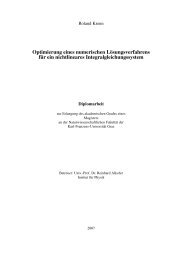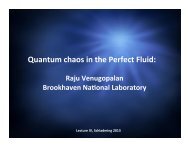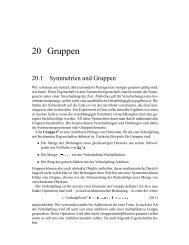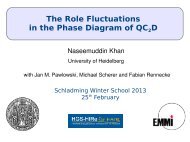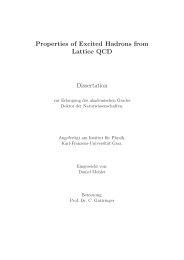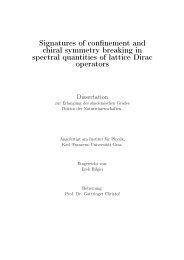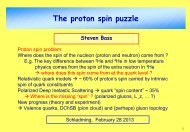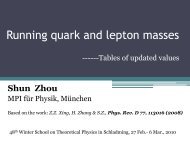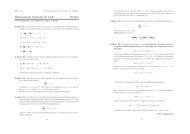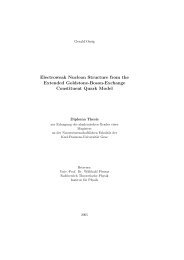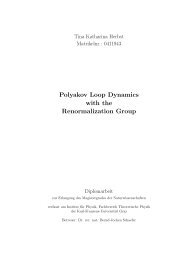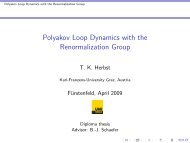The QCD Quark Propagator in Coulomb Gauge and - Institut für Physik
The QCD Quark Propagator in Coulomb Gauge and - Institut für Physik
The QCD Quark Propagator in Coulomb Gauge and - Institut für Physik
You also want an ePaper? Increase the reach of your titles
YUMPU automatically turns print PDFs into web optimized ePapers that Google loves.
Chapter 3. Remarks on <strong>QCD</strong> <strong>in</strong> <strong>Coulomb</strong> <strong>Gauge</strong> 19<br />
whereas approximate equality was found with a different method for the SU(2) group<br />
[CZ03]. In a second period of lattice calculations the eigenvalue spectrum of the Faddeev-<br />
Popov operator became the ma<strong>in</strong> topic of <strong>in</strong>vestigation. <strong>The</strong>re conf<strong>in</strong>ement is related to<br />
the near-zero eigenmodes of the Faddeev-Popov operator [GOZ05] <strong>and</strong> relations to the<br />
vortex conf<strong>in</strong>ement scenario are found.<br />
3.4 Quantisation of Maxwell theory<br />
In the follow<strong>in</strong>g we will show how to formulate Yang-Mills theory <strong>in</strong> <strong>Coulomb</strong> gauge. It<br />
will make apparent how this approach provides access to the <strong>Coulomb</strong> potential of colour<br />
charges <strong>in</strong> an elegant way. For the sake of comparison with the Abelian case we beg<strong>in</strong> by<br />
quantis<strong>in</strong>g Maxwell theory <strong>in</strong> this gauge 1 .<br />
For the quantisation of gauge theories st<strong>and</strong>ard procedures are not applicable. Look<strong>in</strong>g<br />
at the theory of electromagnetism this becomes clear. <strong>The</strong> Lagrangian density of this field<br />
theory is given by<br />
L = − 1 4 F µνF µν + g 0 A µ j µ . (3.5)<br />
Here the four-current j µ = (ρ,j) is a function of the matter fields. Comput<strong>in</strong>g the conjugated<br />
momentum fields gives<br />
Explicitly they read<br />
Π µ =<br />
Impos<strong>in</strong>g usual rules of quantisation 2 , we set<br />
∂L<br />
∂(∂ 0 A µ ) . (3.6)<br />
Π 0 = 0 (3.7)<br />
Π i = F i0 . (3.8)<br />
[µ(x, t), ˆΠ ν (y, t)] = iδ ν µδ (3) (x − y) . (3.9)<br />
Compar<strong>in</strong>g this to (3.7) we have clearly a contradiction. Modified rules for quantisation<br />
with constra<strong>in</strong>ts are required. <strong>The</strong> orig<strong>in</strong> of their formulation is due to Dirac [Dir].<br />
From the viewpo<strong>in</strong>t of Dirac quantisation, the choice of a gauge consists of the replacement<br />
of an arbitrary function by a well-def<strong>in</strong>ed one <strong>in</strong> the Hamiltonian. <strong>The</strong> gauge<br />
conditions can be classified <strong>in</strong>to three classes.<br />
• Class I: <strong>Gauge</strong> conditions <strong>in</strong>volv<strong>in</strong>g only A a k<br />
canonically conjugate momenta πk a.<br />
<strong>and</strong> their<br />
1 This chapter employs the conventions A.1 <strong>and</strong> B .<br />
2 A hat “ ˆ ” over a quantity is supposed to denote the associated operator.



